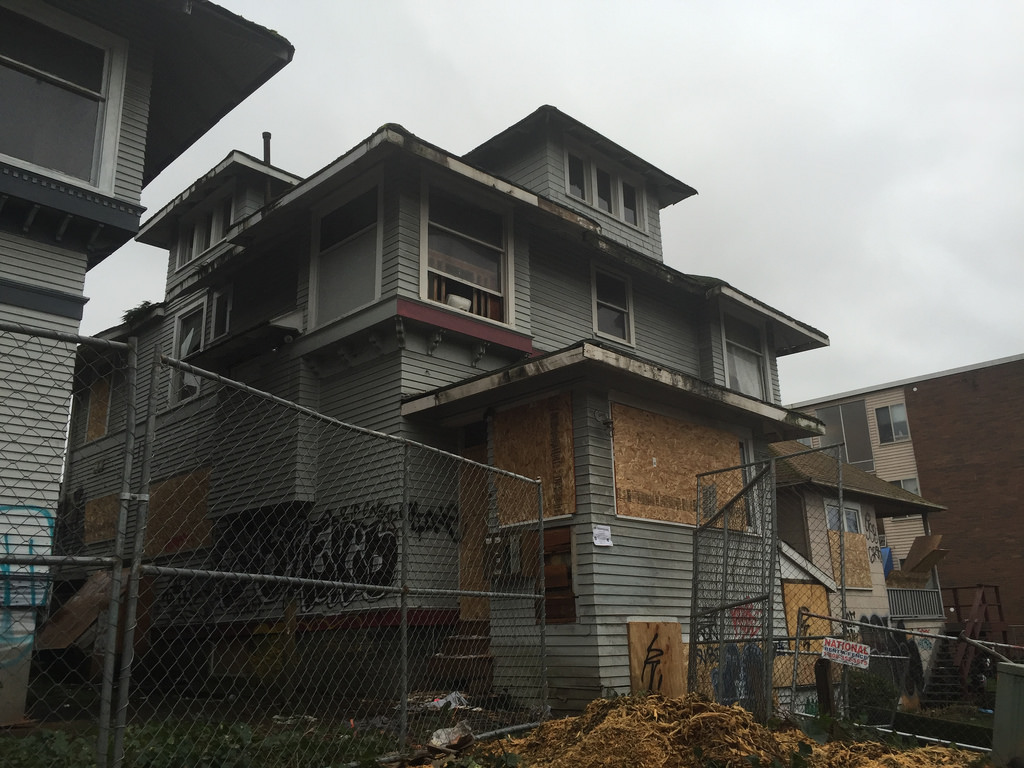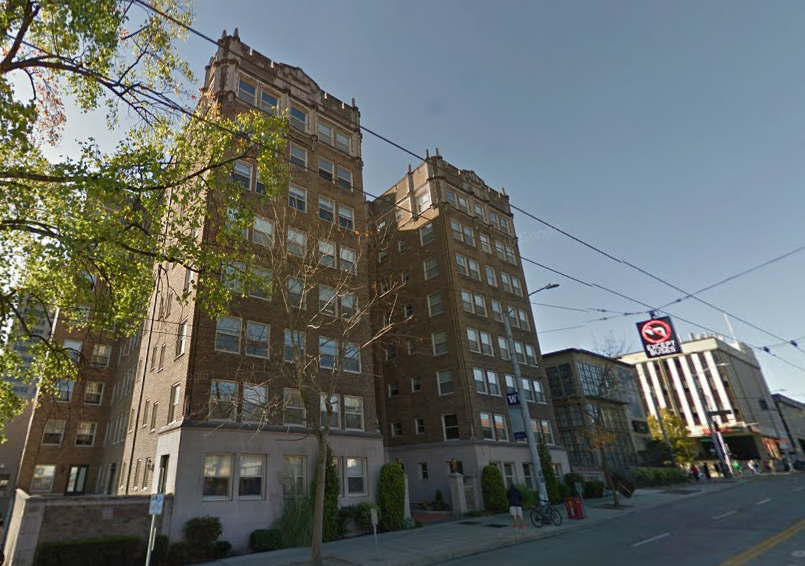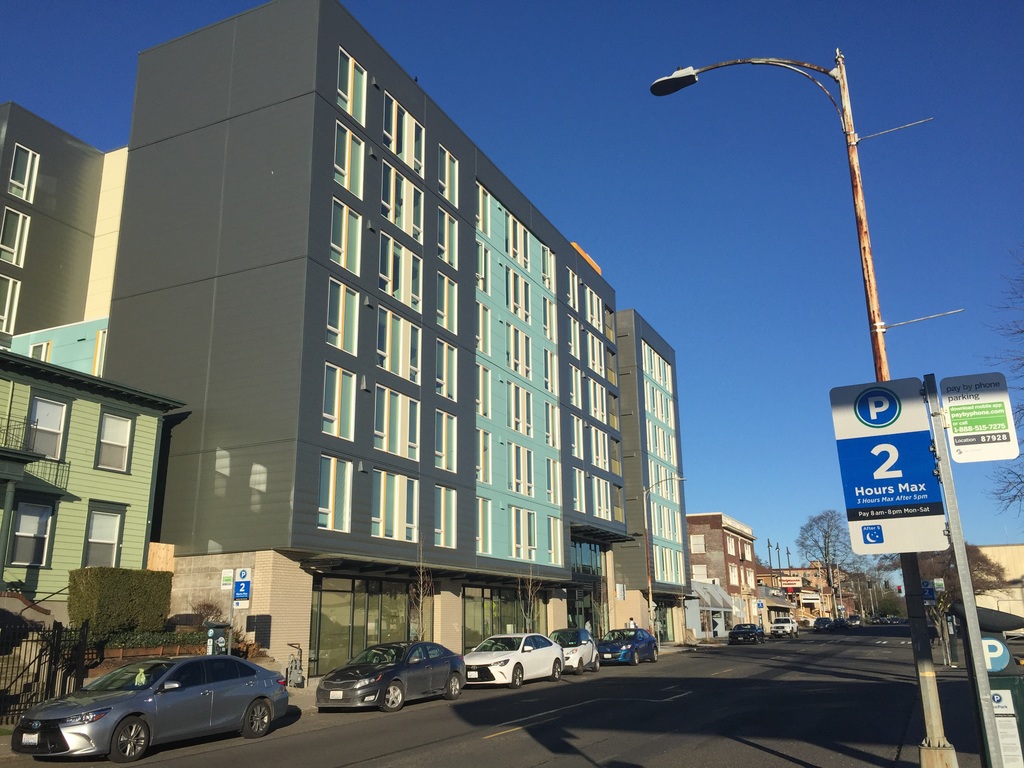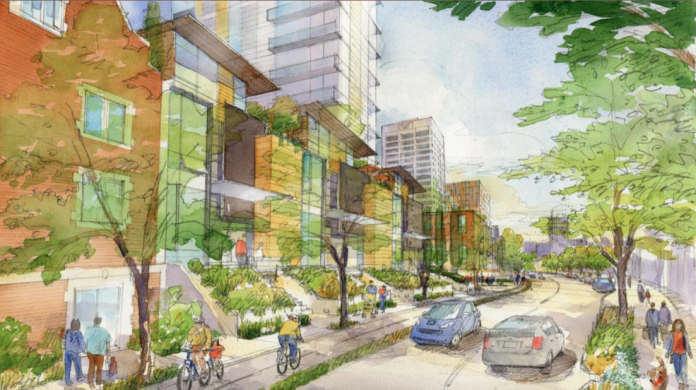In an article last week, Daniel Beekman of The Seattle Times outlined two competing estimates of potential displacement due to the upcoming University District rezone. The first was a thorough, honest analysis generated by the Office of Planning and Community Development (OPCD). The second was a survey tallying the number of units in older buildings conducted by the Seattle Displacement Coalition (SDC), which is a political organization led by John Fox dedicated to blocking the rezones (and known for turning out droves of neon scarf-wearing activists to shout at City officials.)
Beekman quickly distilled the competing arguments into a concise article and attempted to identify the root cause of the diverging conclusions. However, his reporting doesn’t leave readers with the best understanding. At no point does he suggest one analysis is better than the other or settle on a number that seems reasonable. Readers who don’t have any background to the debate were likely left thinking the City didn’t do its job, and displacement may be as high as 1,500 households. The following quotes from Beekman’s article reinforce this impression:
- “Would U District upzone kill cheap housing? Depends whom you ask” (article headline)
- “As few as 40 housing units demolished. Or as many as 1,500 households pushed out.” (first sentence in the article)
- “40 to 275 housing units demolished? Or 1,500 households gone? LaClergue’s numbers don’t consider economic displacement, and even when it comes to direct displacement, 40 is hard to believe. The U District has lost 124 units to demolition since 2010. But Fox’s number assumes a doomsday scenario and blames all direct and economic displacement exclusively on the upzone, even though people are being pushed out regardless.” (closing section)
- “But neither number tells the entire story.”
These quotes imply equivalency and represent SDC’s numbers as an unlikely but possible scenario. The OPCD report is positioned as an argument from proponents, implying it’s biased. Both reports are presented as partially correct and partially incorrect. This does a disservice to readers looking for a reasonable estimate.
Correctly Assessing Fox’s Data
OPCD already outlined problems with SDC’s data. The Seattle Times describes it as unscientific and a doomsday scenario but that doesn’t go far enough. The numbers aren’t actually an estimate of displacement caused by the rezone. It’s simply a survey of old buildings in the University District.

SDC conducted a survey of “potentially vulnerable [low-income] and affordable housing units in all blocks in the U District proposed for upzoning” and identified 1,500 vulnerable units. In order for 1,500 units to be vulnerable, they would all need to face demolition, renovation, or rent increases. No time frame was given for demolitions. This is likely because SDC didn’t conduct an analysis to predict expected construction. Without at least estimating how much construction will occur over a specific time, it’s impossible to understand demolitions.
John Fox from SDC indicated that the City’s estimate of growth was unreasonable and said “a more responsible analysis would’ve assumed development closer to maximum buildout, maybe around 80% of capacity.” Unfortunately, OPCD doesn’t have the privilege of working with assumptions and did an actual analysis of growth. SDC didn’t conduct an analysis or research supporting a higher growth estimate or refuting the ity’s growth estimate. Any estimate of displacement must include calculating demolished units. However, without a time frame and without a construction estimate it’s impossible to project demolitions. In other words, SDC’s number isn’t a real estimate.
Misleading Misinformation
SDC’s report isn’t just missing critical elements, it’s also purposely misleading in a number of different ways.
First, SDC blurs the line between losing affordable units and displacing households. It’s a shame to lose affordable units, but it’s different than displacement. It’s common for higher-income households to rent affordable units, which is called down-renting. These households could move into alternative units in the same neighborhood if their existing unit was demolished, renovated, or faced a rent increase. Even if Fox’s 1,500 units succumbed to these problems, he doesn’t answer how many of those units are home to low-income households. Surely at least one household has higher income. Yet the report doesn’t revise its estimate below the initial survey of 1,500 units.
Second, SDC’s report doesn’t consider an alternative. Even if we assume Fox’s numbers and sentiment are right, without an alternative we don’t know if the rezone is simply the best of many bad situations. When I spoke with Fox, it’s clear he strongly believes that the rezone will exacerbate problems compared to the status quo, but there’s no analysis of this assumption. It’s simply an assumption. Alternatively, OPCD’s analysis started with assumptions about growth and looked at multiple alternatives to understand which had the best outcomes.
Third, it’s possible–in the loosest sense of the word possible–that some of the buildings SDC surveyed will be redeveloped, but it’s extremely unlikely. The Malloy Apartments account for 123 units and were mentioned in The Seattle Times article. The building currently has a FAR of 7. The rezone would allow a FAR of 9 to 10. Unless there’s structural damage to the building, it doesn’t make sense to redevelop the building and in any case, it would likely qualify for historic preservation under the City’s landmarks ordinances (not to mention that it could qualify for other incentives).

Fourth, SDC glosses over how property taxes work. It is likely that property taxes will rise, but it’s really hard to say how much of that is due to rezones. The Housing Levy, transportation spending, and other measures will cause property taxes to go up. Rezones could potentially increase land values, but that doesn’t prove they will increase property taxes. A property’s value has to increase relative to other properties in order to see a property tax increase. Old buildings will depreciate and continue to see their improvement values decrease, even if their land values increase. At the same time, new development will see both land values and improvement values increase. This dynamic means it’s possible older buildings will see their overall value decrease relative to other properties, even if the land value increases.
Lastly, Fox’s report doesn’t conduct any sort of cost/benefit analysis. While criticizing the City’s estimate of affordable housing production, he states, “410 new units doesn’t come close to replacing 1,250 affordable low- and moderate-income units that could be lost.” (Fox’s numbers were published before the current estimate is 600 to 900 units). This doesn’t examine the difference between displaced households that get access to relocation assistance but otherwise wouldn’t without a rezone. It doesn’t consider the benefit of rent-restricted units over low-cost, private market units (which have no guarantee of remaining affordable). And he doesn’t acknowledge the need to provide new affordable housing as opposed to old dilapidated housing. He simply states that the numbers are different.
Ignoring down-renting, avoiding a comparison of alternatives, including implausible buildings, glossing over the nuance of property taxes and overlooking a cost/benefit analysis are all intentional strategies. That context and nuance detracts from the political message that the rezone is bad, an opinion that was established long before the survey was done.
The Question Of Economic Displacement
Even after disregarding SDC’s numbers, Beekman and SDC are positing a real criticism. OPCD’s 20-year estimate of 40 to 275 demolitions seems low considering there were 124 between 2010 and 2016. At first blush this number seems ‘incredible’ as Beekman indicated. However, there’s strong evidence that this may be realistic. If the University District experienced the same ratio of new units to demolished units over the next 20 years, it would have have under 275 demolitions. After asking Dave LaClergue, Area Planning Manager for OPCD, about this, he also added that the rezone should change the ratio. “Lower density lots are more likely to redevelop under the rezone.” If the University District allows high-rises, the ratio might be closer to Downtown, 30 new units for every unit demolished. Applying Downtown’s ratio to the growth estimate would put demolitions between 39 and 50 units.
That’s just demolitions though. The biggest criticism from Beekman and SDC appears to be that the report didn’t put a number on economic displacement, when units remain in place but rents increase beyond existing tenants’ means. More generally, at the heart of most rezone debates is a question about whether or not upzones improve or exacerbate displacement. SDC has made up their mind and begins their survey and other activism from the view that rezones exacerbate displacement. Authors at The Urbanist have argued otherwise.
LaClergue acknowledges this debate is not resolved but reiterated that he did consider economic displacement and wrote about it in the report. However, putting a number on it seemed inappropriate because there simply aren’t tools for predicting this. Additionally, while SDC has made up their mind, there is some evidence from the California Legislative Analyst’s Office that higher density zoning actually reduces economic displacement. This evidence is not definitive. It doesn’t meet the standard of academic research. However, an academic group out of Berkeley that works on gentrification and displacement issues reviewed the paper and thought its findings were legitimate.

Beekman describes OPCD’s estimates as ‘incredible’ and simply doesn’t appear to believe them; he then pinpoints the lack of economic displacement as a possible cause and a mistake by OPCD. It’s understandable where he is coming from but their projections aren’t out of line with what’s seen in other academic research on displacement.
The Urbanist has previously covered one of the best pieces of research on gentrification out of the Federal Reserve of Philadelphia. The paper first identified gentrifying neighborhoods in Philadelphia and then measured the increase in mobility of residents in those neighborhoods compared to non-gentrifying neighborhoods. They found that mobility in the worst cases of gentrification increased 3.6%. However, the average increase in mobility was only 0.4%. Measuring displacement is really hard and there are criticisms of this approach but it does capture both direct and indirect displacement.
SDC is basically asserting that the University District rezone will cause development and rent increases, factors that are inherent to gentrifying neighborhoods. An unscientific, crude, back-of-the-napkin extrapolation from the Philadelphia numbers would indicate about 360 households (3.6%) might be displaced in the worst case scenario from both direct and indirect displacement. In the average scenario, it might be 40 (0.4%), an amusingly similar number to the OPCD estimate. Of course, this makes OPCD’s estimates seem far from ‘incredible.’
If economic displacement is reduced by higher-density zoning, it’s misleading and inappropriate to criticize OPCD’s study for having implausibly low numbers. It’s especially misleading to publicize much higher numbers because OPCD left out a consideration that might reduce their estimate.
When discussing these numbers with LaClergue, he said:
We weren’t trying to manipulate it to come up with the lowest number possible. If we were trying to come up with the lowest numbers, it would be very easy to pick sites in the U District that showed zero units would be demolished. I don’t think that will happen and that’s not what we are doing.
That’s a quote from a professional whose job and desire is to produce the best analysis possible in order to get the best outcome. Unlike SDC, he’s not producing numbers to manipulate public opinion to get a political outcome he already decided on.
The Role Of Media
In the end, we have two reports. One considered the nuances and used professional analysis. The other was a survey of old buildings. It seems pretty clear to me that there is no equivalency between these reports.
Even worse though, The Seattle Times article plays into the political strategy of SDC. Fox made it clear that he cares deeply about low-income residents and even supports policies that urbanists could get behind. In fact, he was an early supporter of inclusionary zoning, something Seattle should’ve adopted long ago. In this particular situation though, SDC’s end goal is to prevent rezones. Ironically, without the rezones SDC opposes, there’s no inclusionary zoning in the University District.
Media should help us get to the truth. If The Seattle Times is convinced LaClergue is wrong, they should be willing to publish their own analysis that comes up with a different number, not give a soapbox to highly politically motivated players in the policy debate and place their manufactured numbers on equal footing.
Don’t Renegotiate The Grand Bargain, Pass M2 Upzones To Unlock 11% Requirement
University District Rezone And Urban Design Proposal Sees Alterations

Owen Pickford
Owen is a solutions engineer for a software company. He has an amateur interest in urban policy, focusing on housing. His primary mode is a bicycle but isn't ashamed of riding down the hill and taking the bus back up. Feel free to tweet at him: @pickovven.

